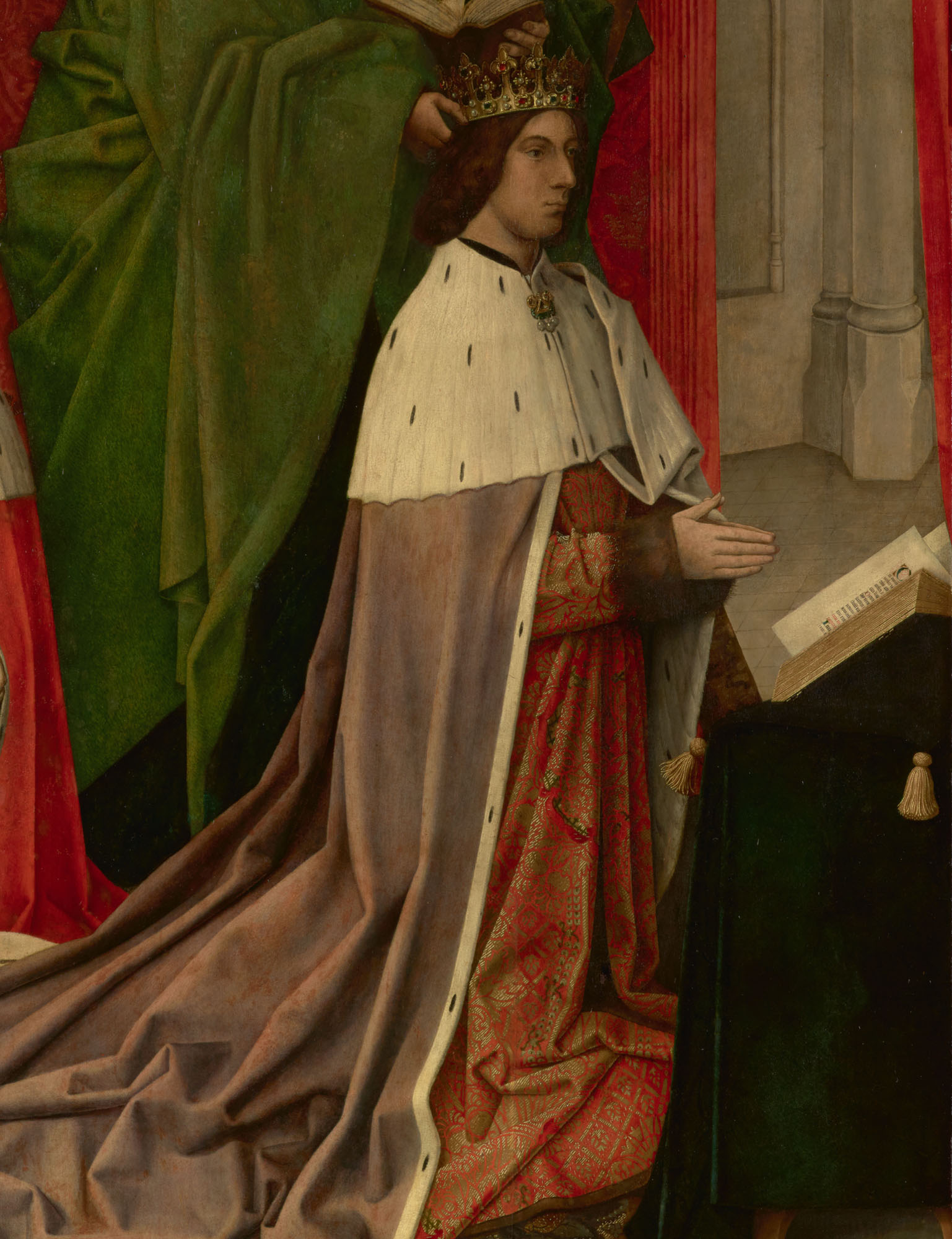

In January 1636 Charles I asked his wife, Henrietta Maria (1606–69), whether she had heard any news of a group of paintings that Cardinal Barberini was sending from Rome. ‘I’m afraid,’ she said, ‘that they’re not coming any more.’ Seeing his face fall, she burst out laughing – ‘that’s because they’re already here!’ According to the Queen’s confessor, Fr Philip, who witnessed the exchange, ‘the King was delighted with this joke’. After the paintings had been unpacked, the Queen had them brought to her bedroom at St James’s Palace. As each was shown to her and to the papal agent, Gregorio Panzani, who had arranged the gift, she and her ladies praised them, particularly ones said to be by Leonardo da Vinci and Andrea del Sarto. Alerted by a message from the Queen that the paintings could at last be seen, Charles went straight to her bedroom, accompanied by the architect and designer Inigo Jones (1573–1652), described by Panzani as ‘a great connoisseur’. ‘The very moment Jones saw the pictures,’ wrote Panzani to Barberini, he ‘put on his eye-glasses, took a candle and, together with the King, began to examine them very closely’. Panzani was amused by Jones’s boastful assertion a few days later of how he had been able to attribute the paintings correctly to their artists, despite the King having removed the labels that Panzani had helpfully attached to them.
This vivid story marks a turning point in the history of the Royal Collection. Barely half a century after Queen Elizabeth had unwittingly revealed to Nicholas Hilliard her ignorance of Italian art, the King and his artistic adviser were examining a gift of paintings from Rome like well-seasoned experts. Charles’s behaviour bore out Panzani’s earlier advice to Barberini that the King had a ‘good nose’ for painting and would probably appreciate old works rather than modern ones, because of their comparative rarity. This change since Tudor times in the appreciation of art broadly coincided with Elizabeth’s death in 1603 and the inheritance of the crown of England by the royal house of Scotland, the Stuarts, but that was largely a coincidence. Far more important was the development, since the mid sixteenth century, in the princely courts of Europe of a competitive fashion for collecting works of art, not purely for their subject matter but as examples of the achievements of admired masters.
From the fifteenth century onwards, study of classical authors had revealed that the ancient Romans eagerly collected works by famous artists, such as the painter Apelles and sculptor Praxiteles. This led scholars and collectors both to look for surviving works by these masters and to seek out their modern equivalents. Paintings and sculptures became a special focus of interest partly because, unlike gold and silver plate, or tapestries woven with precious metal thread, they appealed primarily to people with a knowledge of art and antiquity. Such an understanding was comparable to the ability to read the works of Latin and Greek authors, a skill that, by the sixteenth century, princes were expected to possess, as Queen Elizabeth’s linguistic expertise had demonstrated.
This new appreciation of the visual arts as a continuation of classical traditions of collecting and display was first evident in the courts of Italy, which helps to explain why in the second half of the sixteenth century Italian painting and sculpture achieved a pre-eminence that has never subsequently been questioned. By the turn of the century, monarchs and princes throughout Europe were seeking to emulate the example of such celebrated dynasties of collectors as the Medici in Florence. The standards to which they aspired were embodied by Isabella d’Este, the Marchesa of Mantua, who between 1490 and her death in 1539 had spent much energy and large sums of money in acquiring not only classical antiquities and works by her court artists, Mantegna and Costa, but also paintings, drawings and sculptures by many of the most famous Italian artists of her time, including Perugino, Bellini, Leonardo da Vinci, Michelangelo, Correggio and Titian. She would not have been surprised to know that after her death her treasures would be eyed covetously by the monarchs of Europe, but she would surely have been startled to learn that they would leave Mantua not for Rome, Paris or Madrid, but for far-off London, to adorn the palaces of a dynasty of which Isabella would have known almost nothing.
Monarchs of Scotland since the late fourteenth century, the Stuarts were firmly tied into north European dynastic politics by marriage. James III (1451–88), who reigned from 1460 to 1488, married Margaret, a daughter of Christian I of Denmark, a union that is celebrated in the finest fifteenth-century portraits in the Royal Collection (fig.33). Painted in 1478 by Hugo van der Goes (c.1440–82), one of the leading artists in the Netherlands, the King and Queen are shown on two panels of a triptych that was originally focused on a now lost panel of the Virgin and Child. As a document of royal patronage, however, the opulent beauty of these paintings gives a misleading impression: the triptych was not commissioned or paid for by the King, but by the man who is depicted on the reverse of one of the panels, Sir Edward Bonkil, an Edinburgh merchant who traded with the Netherlands. The young prince who also appears in the painting succeeded his father as James IV. Although he was a patron of architecture – an interest shared by his son James V (1512–42) – the early Stuarts could not equal the artistic achievements of the Tudors: Scotland was simply too poor (its population is estimated to have been only half a million in 1500, less than a quarter the size of England’s) and too politically unstable. Since 1406 every monarch had succeeded as a child, and this pattern was maintained on the death of James V, whose heir was his week-old daughter, Mary, Queen of Scots.

The trajectory of Mary’s tragic story, from her brief reign as Queen of France, through a stormy six years as a Catholic Queen of Presbyterian Scotland, to abdication and eventual execution in 1587, hinged on the lurid events of 9 February 1567. Two years earlier she had married her cousin Henry Stuart, Lord Darnley (1545–67), but despite the birth of a son, the future James VI, in 1566, Mary was deeply unhappy with her volatile husband, and refused, to his fury, to grant him the status of king. It was undeniably to her advantage that on that February night he was found dead in the garden of the Old Provost’s Lodging in Edinburgh, after the house itself had been wrecked by an explosion. Mary’s subsequent marriage to the Earl of Bothwell, who was assumed to have murdered Darnley on her behalf, was a major factor in her downfall. Darnley himself was lamented only by his parents, the Earl and Countess of Lennox, whose grief and anger were distilled into a large painting showing their infant grandson, James VI (1566–1625), kneeling before an altar (the Lennoxes were Catholic), with the Earl and Countess and their younger son behind him (fig.34). Darnley is shown on a tomb in effigy, in gilded armour. An inset painting bottom left depicts the events at Carberry Hill in 1567, when Mary’s army submitted to forces hostile to Bothwell, the event that led the Queen to flee to England. According to one of its many inscriptions, the painting was commissioned by the Countess of Lennox for her grandson, so that if she and her husband did not live long enough to tell him to take revenge on his father’s murderers, the painting would do it for them. Libellous inscriptions referring to Mary’s part in Darnley’s murder have been expunged, perhaps at the wish of James VI, who after he succeeded to the throne of England rehabilitated his mother’s memory by having her buried in Westminster Abbey.
Although the painting belongs to a genre in Scottish art known as the ‘revenge painting’ – an embodiment of the factionalism and blood feuds of aristocratic life in Scotland – it was executed in London by an immigrant Fleming, Livinus de Vogelaare (fl. c.1551–1600), whose only known painting this is. Thanks largely to the links between the Stuarts and France in the sixteenth century there are fine portraits of the Scottish royal family in the Royal Collection, including the miniature of Mary, Queen of Scots by François Clouet illustrated in the previous chapter, as well as a version of the same artist’s full-size head-and-shoulders of the Queen, which her grandson Charles I hung in his Cabinet Room at Whitehall. As in England, however, the development of a native tradition of portraiture depended on immigrant artists from northern Europe. Among the earliest was Arnold Bronckorst (fl.1565–85), who in the late 1570s arrived in Scotland to prospect for gold on Crawford Moor in Lanarkshire, a venture bankrolled by his friend Nicholas Hilliard. He found gold, but was prevented from exporting it by the Regent of Scotland, the Earl of Morton, who instead drew Bronckorst into service to execute the first known portraits of James VI.

After Bronckorst returned to London in 1583, he was replaced by another Dutchman, Adrian Vanson (d. c.1604), who executed decorative projects as well as portraits for the King. Ambitions for promoting a native school of painting may be reflected in Vanson being made a burgess of Edinburgh in 1585 on the condition that he instructed apprentices. Nonetheless, when, in 1603, his royal master inherited the English crown, Vanson joined him in London, where his last recorded work is a commission from the Dutch community for decorating a triumphal arch at the Royal Exchange for the new King’s ceremonial entry into the city. As he came within sight of the arch, devoted to the theme of religion and peace, James I was greeted by a boy who proclaimed that God ‘teaches thee the art of ruling; because none but he made thee a King’, a platitude that was to resonate in the half century to come.
James declared that his first years on the English throne were ‘Christmas time’. In Scotland he had enjoyed an income of barely £50,000 a year, but in England during the first year of his reign he spent £47,000 on jewels alone. To some degree, James had no choice about spending more than his notoriously frugal predecessor: unlike her, he had a family, and his wife, Anne of Denmark (1574–1619), and three children, Henry, Elizabeth and Charles, had their own households. James also fully recognised the need to maintain kingly state in public. In 1598 he had written a book in three parts on kingship, Basilkon Doron (Royal Gift), pitched as a code of conduct for his heir; among the advice he gives is ‘that a King is as one set on a stage, whose smallest actions and gestures, all the people gazingly do behold’. In England that entailed a level of display impossible in Scotland. In 1610 James’s secretary of state, Robert Cecil, Earl of Salisbury, calculated that the combined costs of Elizabeth’s funeral, James’s ceremonial entry into London, his coronation and the reception in London of his brother-in-law, Christian IV of Denmark, had amounted to half a million pounds. These were one-off costs, but the King did not neglect his regular public appearances. In particular, he continued the Elizabethan tradition of enacting the Garter ceremonies with splendour.

Nonetheless, James did not place great stress on the visual arts as a way of projecting royal virtue. He did not participate in the court entertainments that so appealed to his wife, and was a reluctant sitter for portraits. He was not a great builder, either, but he did not need to be, as Henry VIII’s legacy of royal houses was more than any of his successors needed, and the Stuarts, like Elizabeth I, occupied a much reduced number. James gave Somerset House on the Strand to his wife, and it was subsequently renamed Denmark House in her honour. She also had the use of the palace at Greenwich and the house at Oatlands in Surrey that had been built by Henry for Anne of Cleves. James showed no great appetite for metropolitan life, preferring to spend his time informally in his hunting lodges at Royston and Newmarket. Sport was also the major attraction of Windsor, which the King visited almost every year to hunt both before and after his summer progresses. Its appearance in his time is recorded in a superb survey of the Castle and its parks and forests drawn in 1607 by John Norden (c.1547–1625; fig.35). This was a gift to the King rather than a commission, and James’s interest in the Castle did not extend to making changes to it. His greatest legacy was not a building, or a work of art, but his sponsorship of the ‘King James’ translation of the Bible. As this suggests, scholarship was at the centre of his cultural endeavours, and no other British monarch has been so prolific an author. He had received a thorough – and frequently bruising – education from one of the leading scholars of classical learning in Europe, George Buchanan, and by 1583 he already had a substantial library, ranging from classical works to political theory, theology, mathematics and languages. Famously, he once remarked ‘they gar me speik Latin ar I could speik Scotis’.
James was unusual among European monarchs in that he had travelled outside his kingdom for peaceable reasons. In 1589 he sailed to Oslo to marry Anna (known as Anne in England), a sister of the Danish King, Christian IV (1577–1648). Both Anne and her brother, who visited London in 1606 and 1614, were deeply interested in music and the arts and there was significant cultural exchange between the two courts. The rise in interest in the visual arts in the early Stuart court initially owed much to Anne. A forceful personality, proud of being the daughter, sister and wife of kings, she broke with precedent by insisting that her eldest son, Henry, born in 1594, join her in England after her husband’s accession in 1603 rather than remaining at Stirling Castle under the guardianship of the Earl of Mar, as was customary for the heir to the Scottish throne. As result, the Prince was, to an unusual degree, brought up by his mother, and his precocious interest in the arts owed a great deal to her example.
Anne also began a tradition at the Stuart court of masques, spectacular one-off theatrical events, performed as part of the court’s Twelfth Night entertainments at Whitehall. Most were designed by Inigo Jones, who had worked his way up from a humble start in the London building trade to become first, from 1610, surveyor to Prince Henry, and then, from 1615, Surveyor of the King’s Works, which gave him overall responsibility for all royal building projects. Jones had gained a deep knowledge of continental art, architecture and languages through several years of travel. As early as 1605 one of his friends expressed a belief that, thanks to Jones, ‘sculpture, modelling, architecture, painting, acting, and all that is praiseworthy in the art of the ancients will soon find their way across the Alps into our England’.
Anne was Jones’s first significant patron, for architecture as well as theatre design. Her interest in modern Italianate classicism was alluded to in two full-length portraits of her by the Flemish immigrant Paul van Somer (c.1576–1622), both painted in about 1617. In one, in which she is dressed for the chase, there is a view of Oatlands in the background, in which the new classical gateway that Jones had designed for its vineyard is prominent. In the other she is shown against a backdrop of an imaginary classical building (fig.36). Yet, intriguingly, the portrait also looks backwards: the Queen’s dress, a farthingale, evokes Elizabeth I – at Oatlands she hung a portrait of herself next to one of the late Queen – and she deploys jewels with an elaboration that Elizabeth would have appreciated. On her collar are diamond brooches in the form of ‘S’, for her mother, Sophia of Mecklenburg, and ‘C4’ for her brother, Christian IV. She wears a diamond cross prominently at her breast; it was an open secret that by 1600 she had converted to Catholicism.
Shortly before this painting, in 1616, Anne had commissioned the Queen’s House at Greenwich, in which Jones introduced to England the austere classicism of the Italian architect Andrea Palladio (1508–80). Jones’s major royal building was the Banqueting House at Whitehall (built in 1619–22), which served a dual purpose as a setting for masques and a throne room for James to receive important guests. Its classicism may well, therefore, have been conceived of as ‘European’ rather than English, reflecting James’s diplomatic ambitions to be seen as an arbiter of continental politics, steering a middle course between Catholic and Protestant powers. Its style, echoing ancient Rome, may in addition have been intended to embody one of the King’s political obsessions, his ‘imperial’ role as the head of a new polity created by the union of the Scottish and English crowns. To his frustration, he could never persuade parliament in either country, both proud of their political independence, to grant him the title of King of Great Britain. The Banqueting House’s significance to James as a projection of his political ideals may be deduced from its prominent incorporation in a full-length portrait by Van Somer showing the King in his robes of state (fig.37). To modern eyes there is an odd contrast between the old-fashioned way the King is depicted, like an image on a medieval seal, and the up-to-date architecture of the Banqueting House, but to James they were simply different aspects of his image as King.
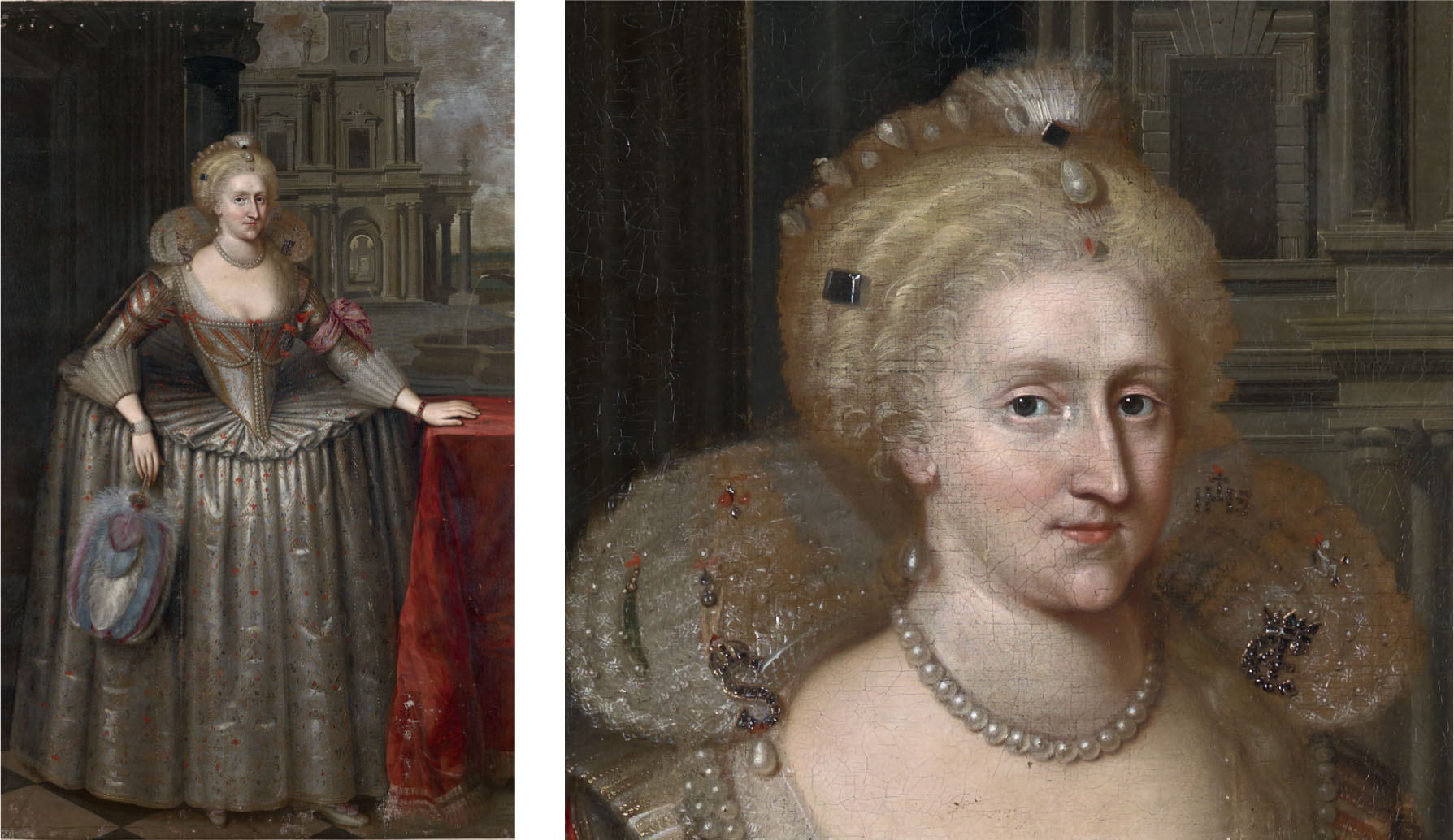
On the leaded window behind the King are engraved or painted the words ‘Dieu et Mon Droit’ (God and my right), the English royal motto since the time of Henry V. The motto had a specific resonance for Henry as an embodiment of the English claim to France. To most English people in James’s reign the idea that England might have an empire referred to rule over Britain and Ireland, with perhaps a memory of the continental conquests of medieval monarchs. Yet it was during James’s reign that the first English overseas colony was established, at Virginia in 1607, the event that is usually taken to mark the foundation of the British Empire. Well before that, trade had established a British presence in many parts of the world – the East India Company received its royal charter from Queen Elizabeth in 1600 – with important consequences for the Royal Collection. Among the collection’s earliest surviving major acquisitions made as a result of trade is a fine Japanese armour by Iwai Yozaemon (fig.38). It was sent as a gift to James from the shogun, Tokugawa Hidetada (1579–1632), in 1613 as a result of a visit to Japan by Captain John Saris of the East India Company to negotiate trading rights, and so is a precious relic of the brief period of direct commercial contact between Britain and Japan that ended with the imposition of isolationism by the shogun in the 1630s, and which was not to resume until 1854.
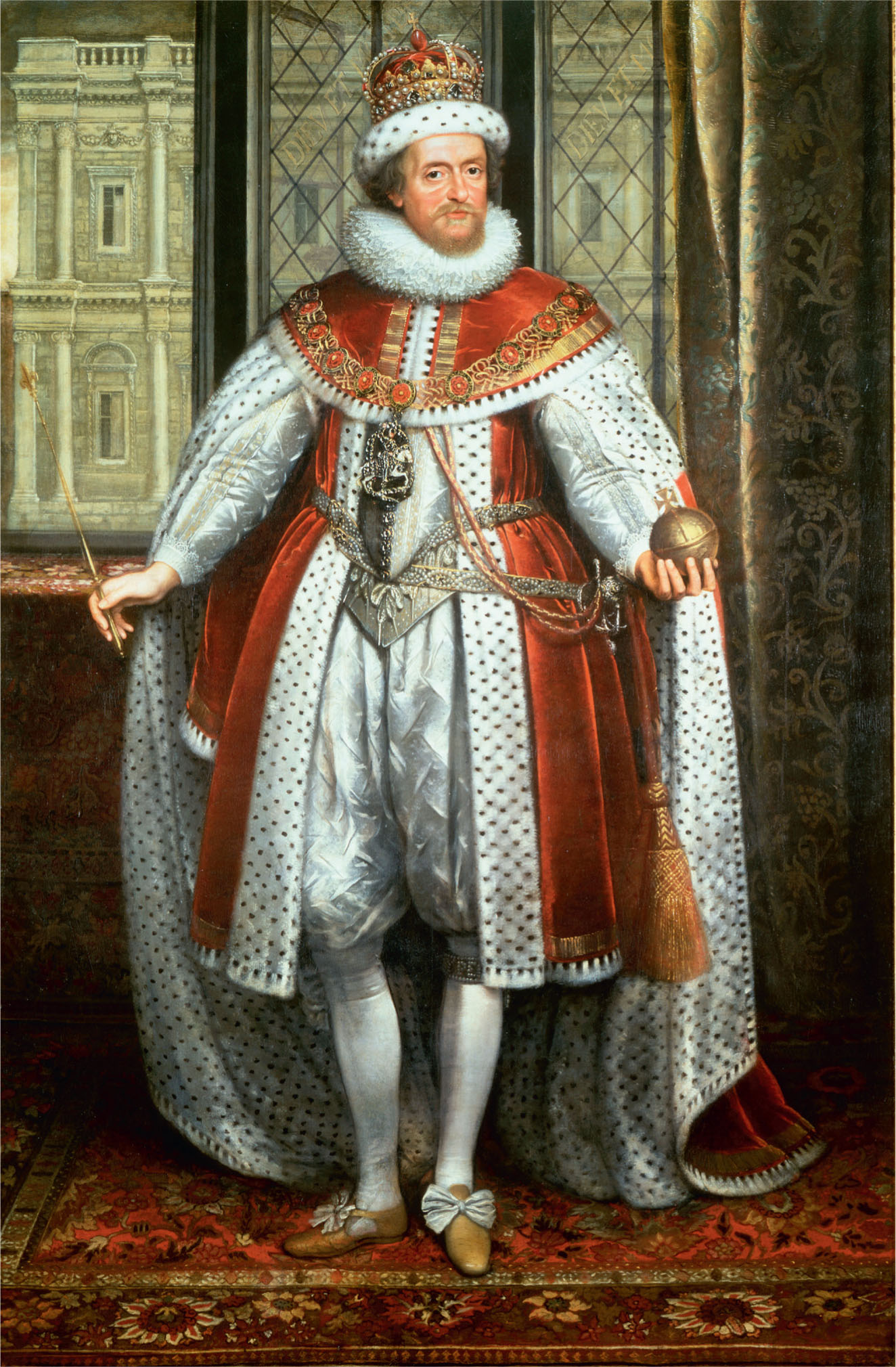
The growth of royal interest in acquiring works of art was stimulated by a new fashion for collecting among a small circle of English aristocrats and courtiers. European travel had become easier, partly as a result of the King having made peace with Spain and France at the outset of his reign, and partly because increased tolerance of Catholics at court eased relations with Italy. Queen Anne’s enthusiasm for paintings struck old-fashioned members of court as eccentric – when Robert Cecil, Earl of Salisbury (1563?–1612), criticised her for spending too much time with ‘dead pictorres’, she replied that she was ‘most contented amongst those hermles pictures in the paltry Gallery, then [he was] with [his] greate imployments’. Confined to Hampton Court in her final illness in 1619, she had some religious paintings brought to her bedside from Oatlands, evidence not just of her Catholic faith but also her devotion to images. Unfortunately, the inventory made of her possessions after her death does not specify the artists of her paintings, but there are clues about the quality of her collection, which included an unusually large number of subject pictures. A painting of nymphs listed in the inventory of Oatlands was probably Diana and her Nymphs Spied on by Satyrs, a collaboration between Peter Paul Rubens (1577–1640) and Frans Snyders (1579–1657) painted in about 1616 that is still in the Royal Collection. Another early Rubens, Judith with the Head of Holofernes (c.1616), owned by Charles I when he was Prince of Wales, may have been inherited from his mother. Anne was also independent in her choice of portrait painters. Although her husband remained loyal to the now elderly Nicholas Hilliard, the Queen preferred the less linear, more naturalistic style of Isaac Oliver, who in 1605 was appointed the Queen’s ‘limner’ or miniature painter. It is likely, therefore, that she commissioned the small drawings by Isaac of mythological and religious subjects that are recorded in the Royal Collection in Charles I’s reign, of which one survivor is Nymphs and Satyrs, a scene of bacchanalian eroticism executed with all the delicate precision that Oliver brought to his portraits (fig.39).
Oliver was also the miniature painter preferred by Anne’s eldest son, Henry, Prince of Wales (1594–1612), which may be evidence of the influence his mother had on him. He certainly shared her enthusiasm for masques and at the age of only 11 was applauded for his outstanding dancing in Ben Jonson’s masque Hymenaei, performed in January 1606. In 1610 Henry was installed as Prince of Wales, which gave him financial and domestic independence. The two years that followed came to be looked back on as an unprecedented flowering of cultural patronage at the English court. In some ways this was unexpected, since, as he entered his teens, Henry seemed more interested in sport. He excelled in the stylised fights of the tilts and barriers: in 1606 the French ambassador described how he ‘studies two hours a day, and employs the rest of his time in tossing the pike, or leaping, or shooting with the bow, or throwing the bar, or vaulting’. Henry also developed a passion for the courtly exercise of the manège, in which horses, in effect, dance on the orders of their riders. Taught to Henry by a Frenchman, M. de St Antoine, it was a skill that was regarded as distinctively royal because it symbolised the relationship between ruler and ruled.
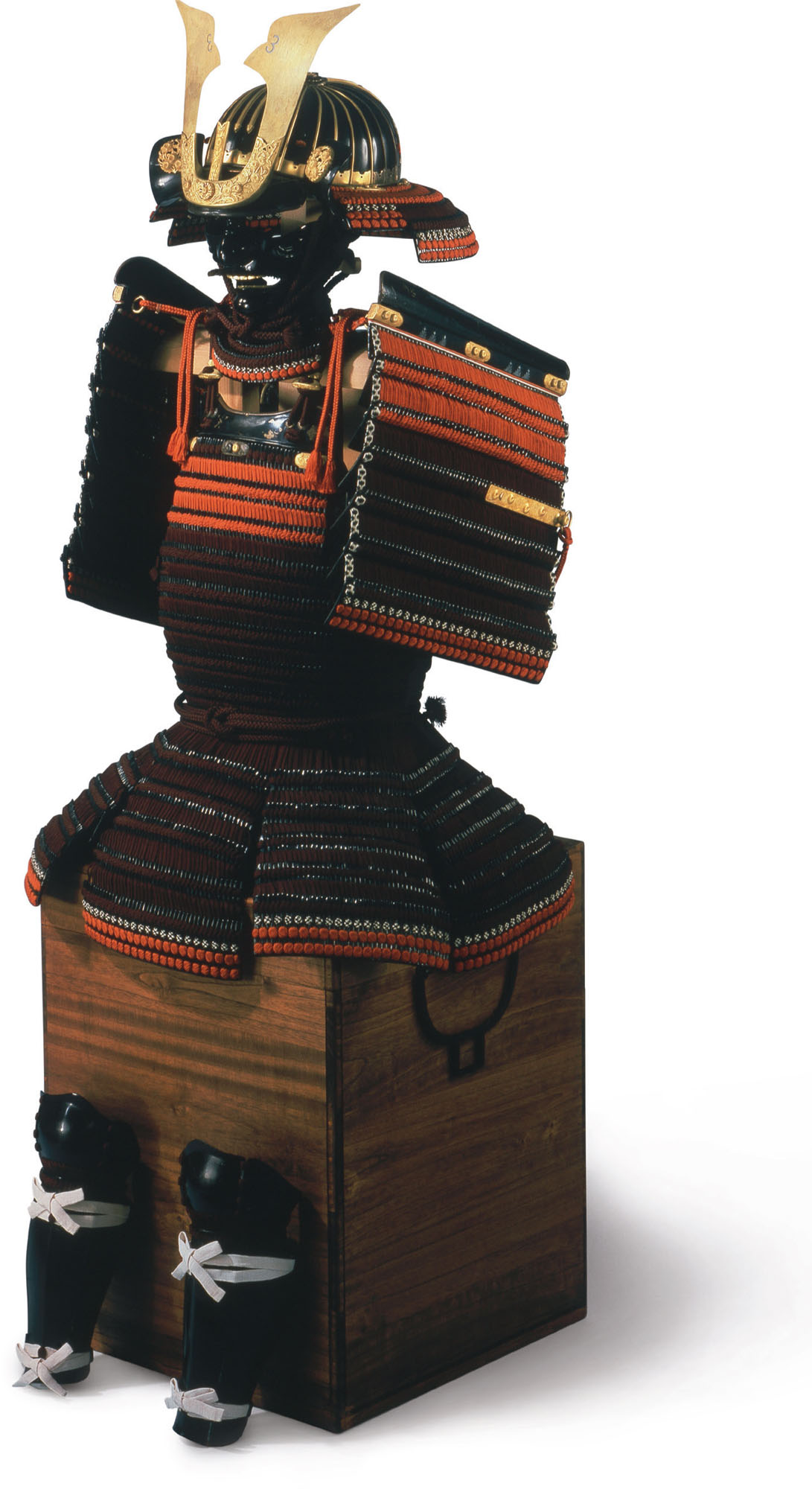

The Prince’s athletic prowess attracted gifts: for example, in 1608 Sir Henry Lee (1533–1611), who had been Queen’s Champion and a favourite of Elizabeth I, gave him a splendid garniture for field, tilts and barriers made in the Greenwich armouries (fig.40). One courtier, John Chamberlain, thought it a waste of money to give such expensive armour to a boy who would soon grow out of it, commenting waspishly that Lee ‘went to present the prince with an armour that stood him in £200 and within a yeare or two will serve his turne neither for jest nor earnest’. That is unlikely to have bothered Henry, who simply acquired more armour as he grew up. Around 1610 he was painted by Oliver in a masterly large miniature (13.2 cm tall) showing the prince wearing field armour, its black ground strikingly embellished with gilt bands of classical ornament (fig.41). In the background is a military encampment. The portrait captivatingly evokes Henry’s aspirations to be a warrior in both the chivalric and classical traditions.
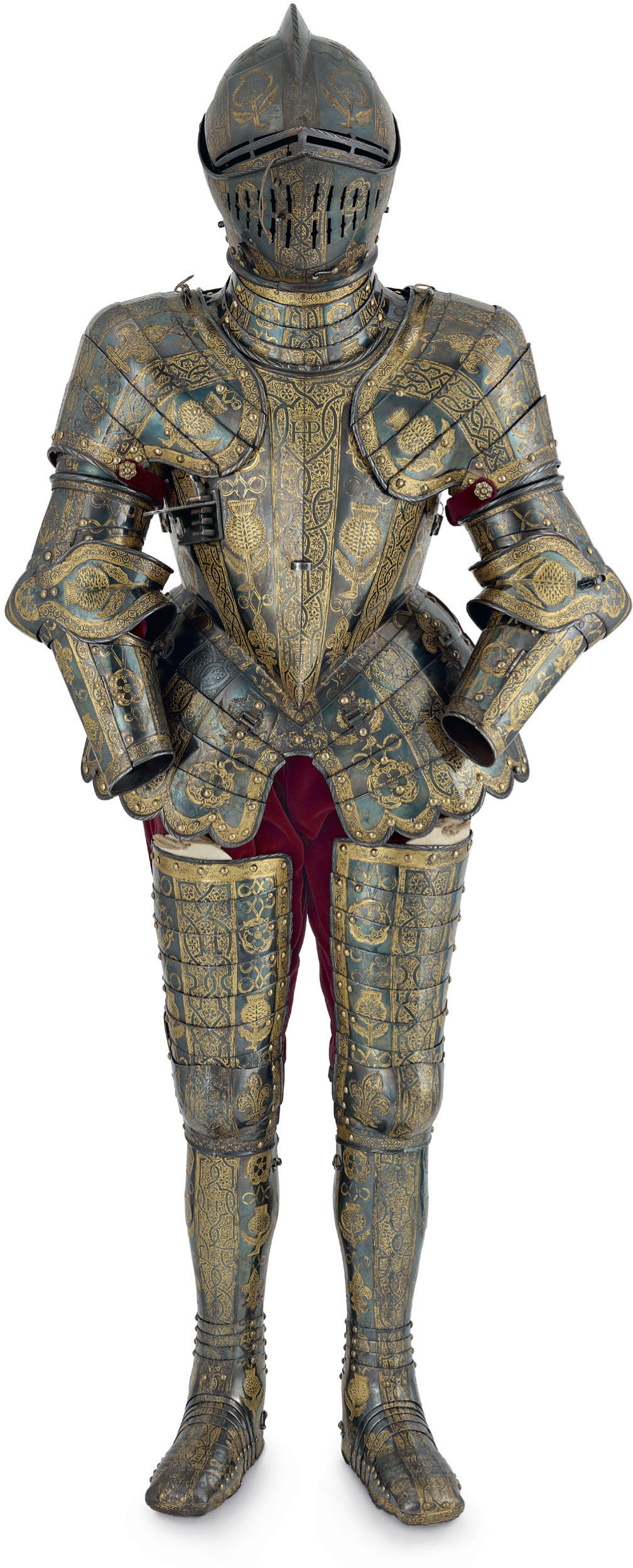
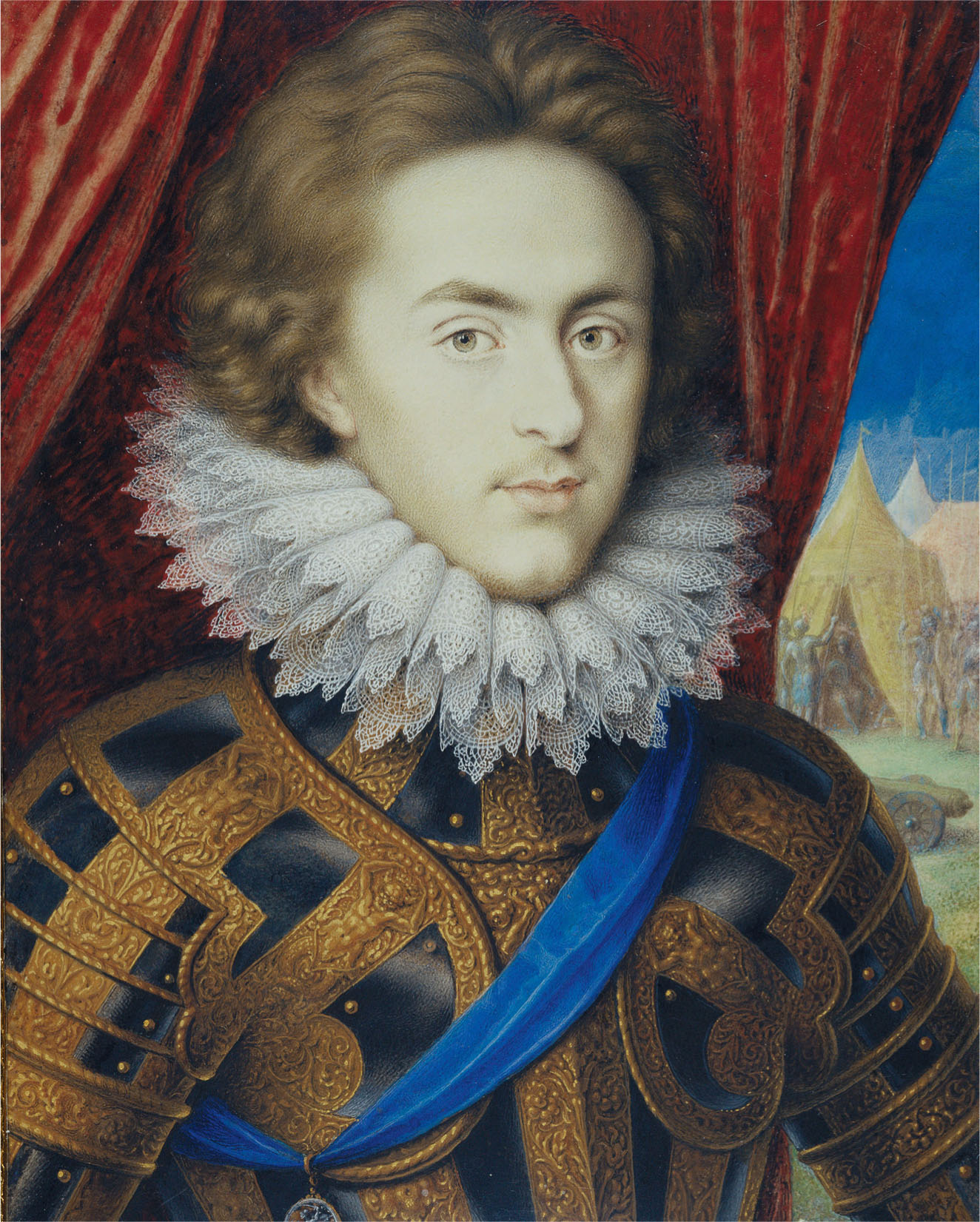
According to one apocryphal story, when James berated his eldest son for not spending as much time at his books as his brother Charles, Henry is said to have replied ‘we’ll make him archbishop of Canterbury’. However, by the time he became Prince of Wales he had begun to demonstrate a strong interest in scholarship. In 1609 he acquired the most celebrated private library in England, formed by one of his tutors, the collector and bibliophile John Lumley (1533–1609). To this new enthusiasm for books, he soon added an acquisitive interest in coins, medals and gems. To accommodate his growing collection, he fitted out a new library at St James’s Palace, which, with Richmond, had been allocated to him for his household. The work was supervised by Inigo Jones, whose appointment as Henry’s surveyor was another link with Queen Anne’s patronage, but the prince never gave him a substantial commission, even when planning an elaborate water garden in the Italian style at Richmond. Instead, Henry recruited a Huguenot hydraulic engineer, Salomon de Caus (1576–1626) – who taught him the art of perspective – and a Florentine painter and architect, Costantini de’ Servi (1544–1622), and Jones was sidelined.
This confident deployment of continental patronage may reflect the influence of courtiers in Henry’s household with a interest in the visual arts. Among the most significant was Thomas Howard, Earl of Arundel (1585–1646), who was to become the outstanding English aristocratic collector of his generation and already had a high reputation for his knowledge of painting. Henry also employed people with a specialist knowledge of art, and in 1612 offered the post of keeper of his cabinet room to a Dutch artist, Abraham van der Doort (c.1575/80–1640), who had worked for a great collector, Emperor Rudolf II (1552–1612). Henry made improvements to the gallery at St James’s, which became the setting for a substantial collection of paintings. His first recorded acquisition was in January 1610, when one of Arundel’s servants was paid £2 for delivering ‘a great picture to his highness’. A group of paintings, including works by Palma Giovane (1544–1628) and Tintoretto (c.1518–94), was bought for him in Venice in 1610 and he snapped up pictures from visiting Dutch dealers. Diplomats were quick to realise that Henry would be pleased with gifts of works of art, and in 1610 the States General of the new republic of Holland presented him with works ‘painted on purpose to adorn one wall of his gallery’. In 1611 paintings were sent by Cosimo II, Grand Duke of Tuscany (1590–1621), following a request from the prince for portraits of famous Italians. The Grand Duke’s representative in London, Ottaviano Lotti, sent back a description of Henry being shown the newly unpacked paintings: he was particularly impressed by a picture by the Mannerist Domenico Beccafumi (1486–1551), ‘which he wanted to place in a particular room so that it could be seen to better effect … His Highness asked me several times about the decoration of their Highnesses galleries and if there were subject pictures and what kind of statues’.
There was more than diplomatic courtesy behind the gift. For some time there had been hopes at the Tuscan court that Cosimo’s sister Caterina de’ Medici might marry Henry despite the difference in religion. A second Medici gift – of 15 small bronze statues after models by the Medici court sculptor Giambologna (1529–1608) – was hurriedly assembled in Florence in December 1611 when it seemed at last that the marriage might go ahead. The sculptures arrived at Richmond on 28 June 1612, and were shown to the Prince in his gallery. Cosimo’s representative, Andrea Cioli, wrote an account of what happened. The Prince was so delighted with them that he kissed the first one that he picked up. While he was lovingly examining them in detail, it was suggested that he might like to give a small bronze horse to his brother, Charles, to which he replied sharply, ‘No, no, I want everything for myself.’ After dinner, Cioli was told that the Prince had taken the sculptures to one of his cabinet rooms, where he had arranged them with great care. Henry was so delighted with the gift that he asked if he might have more such bronzes, including ‘a David by Michelangelo’.
When, barely four months later, the young Prince Charles was taken to his dying brother’s bedside, he sought to comfort Henry by giving him to hold a bronze horse from the Florentine gift. Van der Doort must have heard this story from Charles. Many years later, when he catalogued the ‘little horse’ in his inventory of works of art at Whitehall he described it as the one ‘which your Majesty did send for to Richmond in the last sickness time and there your Majesty gave it with your owne hands to the Prince’. A fine bronze of a pacing horse that is still in the Royal Collection may conceivably be this very sculpture (fig.42).
Henry’s death transformed Charles’s life. The 12-year-old was now the heir to the throne, although he had to wait four years to become Prince of Wales since his grief-stricken parents knew the ceremony would bring back painful memories of his brother. Conquering a stammer and a physical disability probably caused by childhood rickets, Charles sought to emulate his adored brother’s prowess in the tiltyard, the manège and in courtly entertainments; Henry’s interest in art was to be an even more significant influence.
As with his brother, the issue of who Charles would marry became a matter of long, drawn-out debate. In 1623, at the age of 22, Charles travelled incognito to Madrid with George Villiers, Earl (and later Duke) of Buckingham (1592–1628), to meet the Spanish Infanta, Maria, daughter of Philip III. Although the marriage negotiations were a failure, the six months that Charles and Buckingham spent in Spain had a deep influence on them both, since the royal palaces there contained the largest, and probably the finest, collection of paintings in Europe, celebrated, above all, for its canvases by the great Venetian artists, and in particular Titian. Charles sat for his portrait by Diego Velázquez (1599–1660) – tantalisingly, it has been lost – and returned home with some extraordinary gifts from the 18-year-old Philip IV (1605–65). These included a Holy Family with Saint John the Baptist by Correggio (1489–1534), and two masterpieces by Titian, The Emperor Charles V with a Hound and Jupiter and Antiope, usually known as the Venus del Pardo, after the Spanish palace in which it had hung. He was also given the only monumental marble sculpture by Giambologna outside Italy, Samson Slaying a Philistine, which he presented to Buckingham; now in the Victoria and Albert Museum, it is the only part of Philip IV’s gift remaining in Britain. Charles also ordered copies to be made of paintings in Spanish collections and made important purchases in Spain, most entrancingly Titian’s Girl in a Fur (1535), now one of the great treasures of the Kunsthistorisches Museum in Vienna. These Spanish acquisitions transformed the status of Charles’s hitherto modest collection: in 1621 he had owned only 21 paintings.
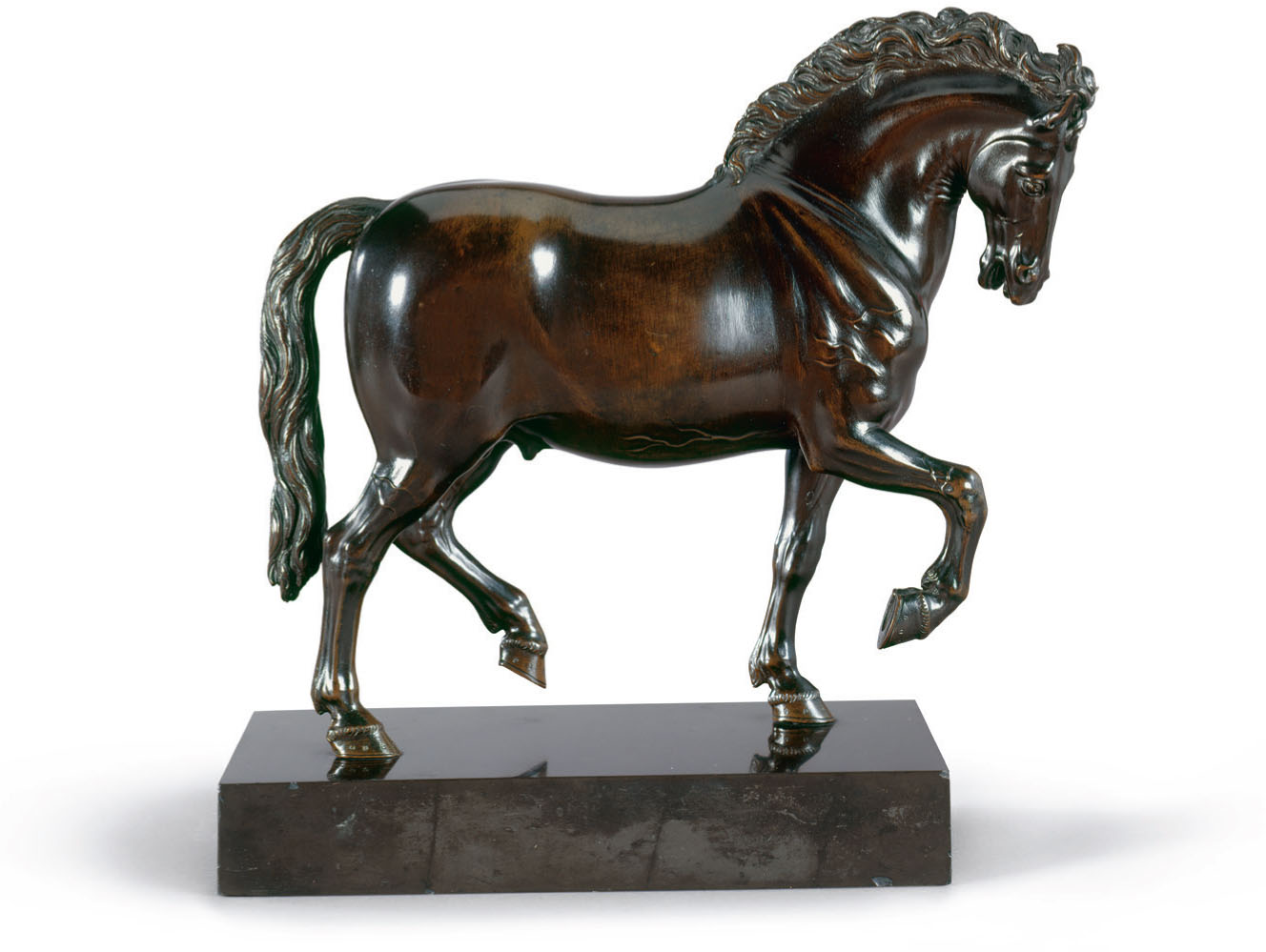
While in Spain, Charles concluded one of the most celebrated acquisitions in the history of the Royal Collection, when he agreed to pay £300 for seven of the ten cartoons commissioned by Pope Leo X in 1515–17 from Raphael (1483–1520) and his workshop for tapestries for the Sistine Chapel (fig.43). Charles would have known what they looked like, since a set of the tapestries bought by Henry VIII were in the Royal Collection (see here). He was also aware of the artist’s status – he later swapped his album of portrait drawings by Holbein for a small painting by Raphael, St George and the Dragon (1504–6), that belonged to the Earl of Pembroke. However, the cartoons were not acquired as works of art in their own right, and were never displayed as such in Charles’s lifetime, because they had been cut into metre-wide strips for use by tapestry weavers on their looms. Charles’s principal motive in buying them was to have them as models for tapestries to be made by workshops at Mortlake, near Richmond, founded in 1619 as one of the few artistic enterprises encouraged by his father, who had granted it a monopoly on tapestry production in England for 21 years. Designed to compete with the finest tapestries woven in Brussels and Paris, the workshops were set up by Sir Francis Crane (c.1579–1636), a courtier who had served successively on the councils of Prince Henry and Prince Charles. All the weavers were brought in from Flanders, and the workshop’s principal designer was a German painter, Franz Klein (d.1658), known in England at Francis Cleyn, who had been employed by Christian IV in Copenhagen.
The Raphael cartoons were kept in storage at Whitehall and loaned to Mortlake when needed for copying by Cleyn (the originals did not go onto the looms). Their importance to the factory was emphasised by Crane’s unsuccessful attempts to buy two cartoons that had not formed part of Charles’s purchase. Charles had a set of the tapestries woven at Mortlake, but only one, The Blinding of Elymas the Sorcerer, survives in the Royal Collection. The level of excellence that the workshops achieved is demonstrated by a partial set of The Twelve Months, ordered by Charles for £500 in 1623, probably for Hampton Court (fig.44). Since Crane’s family did not wish to continue the business after his death, they were bought out by the Crown in 1638. Tapestry weaving continued at Mortlake until 1703, the only English enterprise that can be compared with the French royal manufactories, such as the tapestry works at Gobelins or the porcelain factory at Sèvres. The close interest that Charles took in the venture (in 1625 he promised it an annual subsidy of £2,000) is a reminder that despite the significance of the paintings he acquired, the dominant visual medium at court was still tapestry, just as it had been in medieval and Tudor times.

The Raphael cartoons had probably ended up in Genoa because of trading links between the city and Brussels, where they had been kept throughout the sixteenth century. While in Genoa they were copied in a series of now lost paintings by Rubens. An early tradition that he recommended that Charles should buy the cartoons may well be true, since by 1623 Rubens had significant links with the English court. These are first documented in 1620, when Lady Arundel and members of her entourage had their portraits painted by Rubens while they were in Antwerp, en route for Italy. The initiative in acquiring a painting by Rubens for Prince Charles (who had by then inherited from his mother one or possibly two paintings by the artist) was taken by Henry Danvers, later Earl of Danby (1573–1643), a rich courtier who had earlier served Prince Henry. Using as his agent Sir Dudley Carleton, ambassador in The Hague, he bought from Rubens a painting of a lion, tiger and leopard hunt to give to the Prince. The crucial information that the painting was for Charles was not communicated to Rubens, since the canvas that he agreed to sell was largely by his studio. When it arrived in London, Danvers wrote in distress to Carleton that everyone agreed it had been ‘scarce touched’ by Rubens’s hand, ‘and the postures so forced, as the Prince will not admitt the picture into his Gallery’. Rubens, who had thought Carleton was buying the painting for ‘a friend’, was mortified, and agreed to paint another hunting picture ‘entirely of my own hand’. This never materialised, almost certainly because Danvers finally grasped that Charles did not like such violent subject matter. The incident also reveals that the Prince had access to advisers who could immediately distinguish an autograph from a workshop painting.
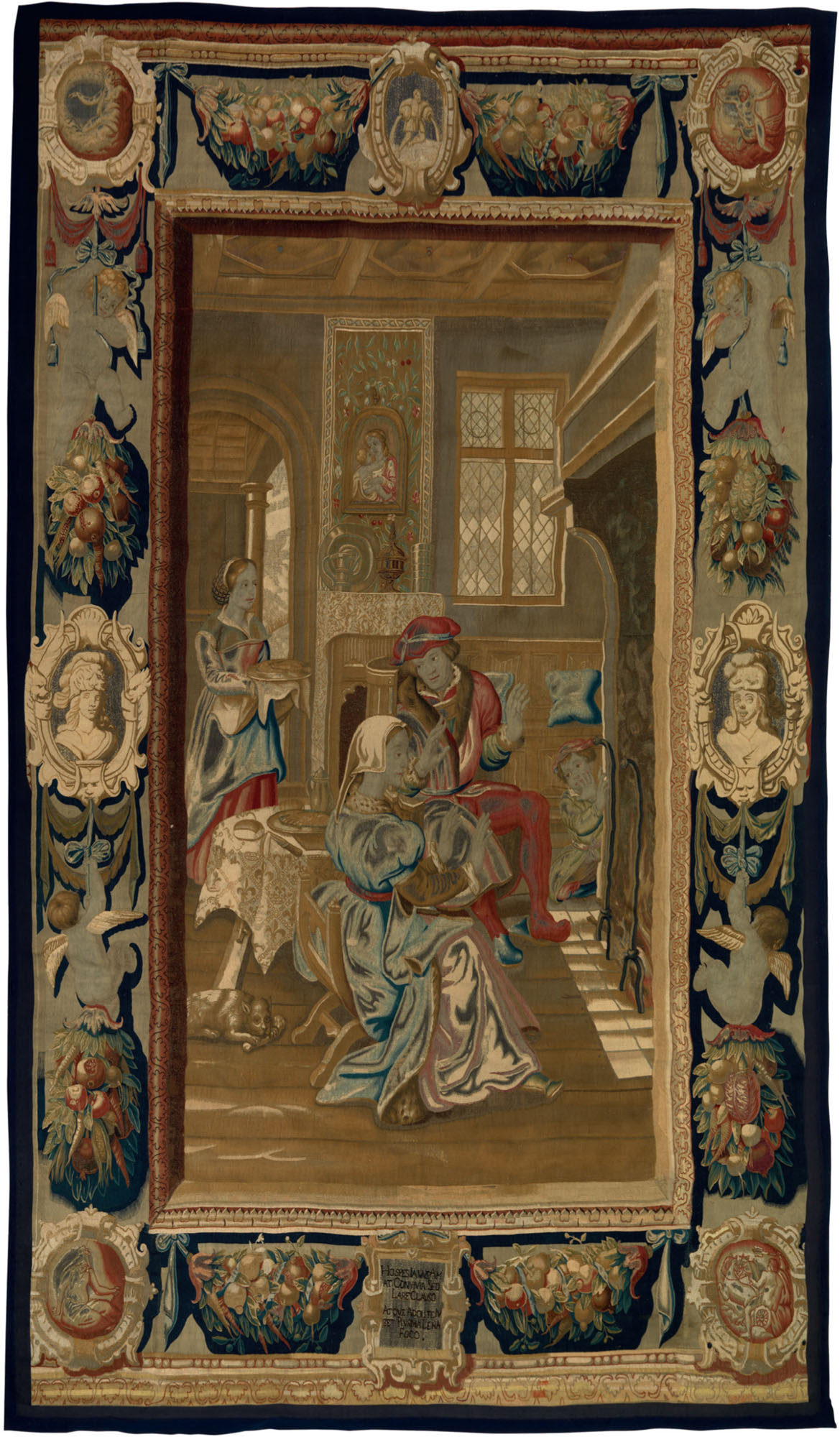

In 1622 Danvers made up for his mistake by commissioning a self-portrait from Rubens to give to Charles, ‘every part of it wrought with his owne hand’, in Danvers’s words (fig.45). Rubens was flattered by the request, writing afterwards to a friend, ‘it did not seem fitting to send my portrait to a prince of such high rank, but he overcame my modesty’. Originally hung at St James’s Palace, it was moved after Charles’s accession to Whitehall, and hung in a place of honour with a group of portraits of artists in the ‘Little Bi-Room between the King’s Withdrawing Room (also called the Breakfast Chamber) and the Long Gallery’. Writing to Charles at the time the painting was delivered, Rubens remarked that, ‘I confess myself to be, by a natural instinct, better fitted to execute works of the largest size rather than little curiosities. Everyone according to his own gifts.’ He no doubt hoped to encourage the idea, first mooted at about this time, that he should provide paintings for the ceiling of the Banqueting House. Rubens’s hope that Charles would offer bigger commissions accurately reflects the growing ambition of royal patronage in the first half of the 1620s as the Prince’s reputation as a connoisseur began to spread throughout Europe. In January 1625, just three months before King James died, Rubens had written to a friend – and so with no intention of flattery – that ‘the Prince of Wales has the greatest love of painting of any prince in the world’, but even he might have been surprised if he could have foreseen with what brilliant success Charles would demonstrate that love once he was King.